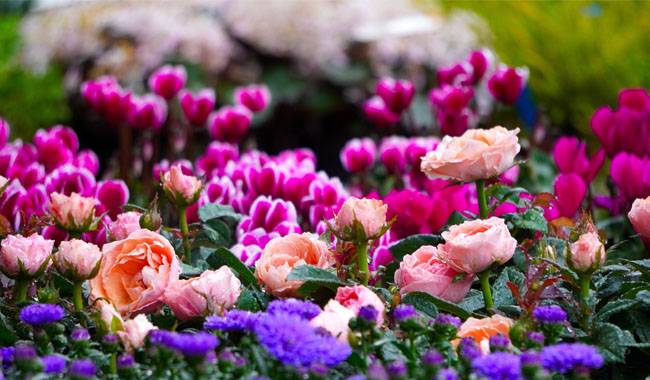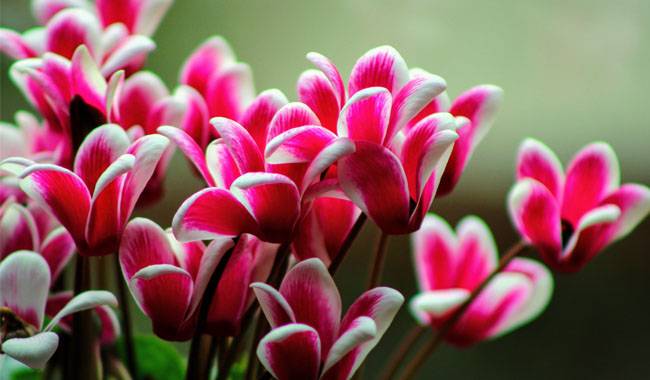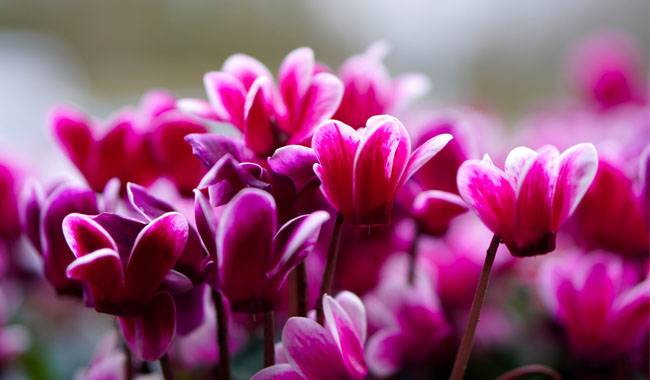
Cyclamen resembles a flock of brightly colored butterflies and is considered one of the most unusual flowering plants. Even with dozens of new species appearing, Cyclamen still defies competition. Cyclamen requires unusual care, conditions, and cultivation techniques, from its tubers to delicate cuttings and upward sloping petals. However, it is still an easy species to care for. It is not at all, unlike other houseplants. But if a novice has a good understanding of Cyclamen, it can be successful. You will learn how to growing cyclamen plants in ThumbGarden’s article.
CYCLAMEN PLANT DESCRIPTION
Cyclamen, Dryas, or Cyclamen persicum is a representative of tuberous plants, or tuberous plants. Cyclamens are characterized by a long, apparently, completely dormant period, beginning with flowering and lasting from spring until late summer, when the first shoots appear. Repeated flowering is often disappointing, so Cyclamen are increasingly abandoned after one season. All they need is the right care and the right conditions to enjoy them year after year.
Large and heavy, up to 6 inches (15 cm) in diameter, Cyclamen’s round, flat, weighty tubers are exceptional. Numerous leaves and solitary flowers grow from the top growing point and are quickly submerged and flooded. Only the larger cultivars reach a height of 12 inches (30 cm) during flowering, but there are also many miniature varieties under 6 inches (15 cm) in height.
Cyclamen’s root leaves are kidney-shaped or broadly heart-shaped, dense, exceptionally textured and glossy, and decorated with a special silvery pattern of light veins. There are varieties with dark, purple, and light-colored leaves. Because the underside is green, it is easy to distinguish Cyclamen from other purple Cyclamen. The largest cultivars reach 6 inches (15 cm) in diameter, while the smaller ones are only 2 inches (5 cm.) Cyclamen’s long, fleshy, reddish petioles are held tightly until the leaves wilt, after which they are easily detached.
The conical petals reach 2-4 inches (5-10 cm) in length, and the petals flip upward, giving Cyclamen’s ovate, five-petaled flowers a touch of originality. This delicate beauty resembles a constellation of tropical butterflies at rest. They constantly bloom on thick and succulent stems and range in height from 6 inches (15 cm). After flowering, Cyclamen form large styles.
Cyclamen is the star of the coldest season, flowering in the fall and winter.
The flowers’ peculiar pinkish-purple hue is not for nothing that they are called Cyclamen. Whether dazzling or delicate, cool pink, white or red Cyclamen is always a showstopper. The plant displays an increasing number of wavy, square, dark-eyed, ruffled, and terry varieties.
GROWING CONDITIONS FOR CYCLAMEN

Stable light, strict temperature control, and heat protection are the keys to a successful Cyclamen planting.
Light and location
Cyclamen are placed in the shade during the stationary period but still have high light requirements during intensive growth and flowering. They will flower only in bright light but not in direct sunlight and will flourish. East and west, partly south-oriented windows are ideal. In winter, especially on cloudy days, repositioning or extra light is just a welcome solution.
Temperature and Ventilation
Normal living room and office temperatures are too hot an environment for Cyclamen. Not only do they bloom very quickly, but they also grow poorly and get sick very often. Their favorite temperature is between 53-59 °F (12-15°C). If the temperature drops to 50 °F (10°C), the plants can easily tolerate it. But a rise to °F (20°C) is already significant stress for them, triggering an accelerated transition to dormancy.
The task of keeping temperatures below 59 °F (15 °C) can sometimes be solved by moving pots closer to glass and window frames, but it is better to find Cyclamen in cool conditions in fixed places on balconies, terraces, porches, verandas, in halls, hallways, corridors, in hallways.
For the vegetation and flowering of Cyclamen, it is necessary to prevent draughts, prevent any sudden changes, and refuse to rearrange. They like fresh air but carefully ventilate the room. Cyclamen can not tolerate polluted air, including cigarette smoke.
CARING FOR CYCLAMEN PLANTS AT HOME

Special Cyclamen, not always complicated. And Cyclamen proves that even though it is different from other plants, beginners can cultivate it.
Watering and air humidity
This plant is so afraid of getting wet that even a drop of water can cause death. The leaves, petioles, and tubers should not be soaked. Instead, water the plant very carefully, through trays, draining excess water after 15 minutes, or use a watering can, wick watering. Overwatering is harmful, and complete drying of the soil can lead to loss of foliage and flowers.
Water Cyclamen, allowing the top layer of the substrate to dry out. As flowering ends, watering is gradually reduced until the tubers that have lost their foliage are almost completely dry, and watering is slowly resumed as active growth begins.
Cyclamen prefers not only soft water but also acidified water. Water with a temperature of 53-59 °F (12-15°C) can be used to prevent overheating.
Cyclamen should not be sprayed but prefers at least moderate humidity. These species will bloom quickly if flowering shrubs are purchased without increasing humidity to “greenhouse.” Foliage needs to be kept clean.
Feeding and fertilizer composition
Cyclamen signals to itself that fertilization has begun. When the leaves are fully opened, and buds appear, they are gently “groomed.” It continues until the end of flowering and is gradually eliminated during the dormant period. The best feeding frequency is every 2 weeks.
Cyclamen do not like too much nitrogen fertilizer and prefer phosphorus-rich fertilizers. You can look up fertilizers for Cyclamen or use fertilizers for succulents, or at the very least, ornamentals, strawberries, tomatoes, and other fruiting species.
Pruning of Cyclamen
This plant is completely intolerant of pruning. Even wilted leaves and flower stalks should be removed by hand and twisted at the base. When flowers and leaves begin to fall off the tuber easily, they should be removed as they wilt naturally.
Repotting, containers and substrates
Cyclamen should be transplanted annually, after flowering and before or after the dormant period, when new foliage grows. The standard time for transplanting is September. If the plants produce daughter tubers, separate them at transplanting.
The pot size for Cyclamen is chosen based on the diameter of the tubers, to which 1 inch (2.5 cm) is added. Cyclamen won’t keep (and won’t make it bloom) in large, too spacious pots, but pots can’t touch the wall.
You can use a special substrate for bulbs and tubers, or a general-purpose loose, light, nutritious substrate with extra sand and perlite (or other loose ingredients.) Cyclamen grows well in a mixture of sand, humus, peat, and foliage (1:1:1:3).
A very high drainage device and a thin layer of the substrate should be placed at the bottom of the container. The tuber should be handled with care. When removing Cyclamen from the pot, only carefully shake off the soil, do not clean it with your hands, and not touch the roots.
Place the tuber so that about one-third of it remains above the soil line and carefully add substrate to the sides. Even lightly buried plantings can cause damage, so it is best to be overly cautious. It is easy to determine the orientation when planting purchased “naked” tubers: they are convex on the upper side.
Pests, diseases and problems in cultivation
Discoloration and loss of leaves and buds is a sad sight. And it is not easy to identify the cause because Cyclamen reacts not only to humidity, spillage but also to high temperatures, too dry air, dry soil, too cold, untimely transplanting during vegetation. Diagnosis” should begin with an inspection, gently “probing” the tubers for signs of swelling and decay. It is also important to assess the moisture content of the soil.
Yellowing leaves often indicate insufficient light and shattered leaves due to improper fertilization.
Cyclamen is often infested with Cyclamen mites and less often with spider mites, thrips, and aphids. Only insecticides can help. However, the main enemy of the plant is rotting in case of overwatering and careless watering.
Propagation of Cyclamen
It is possible to grow Cyclamen from seeds. Still, the process is long and complicated, requiring complete protection from light and a special temperature regime that does not preserve varietal characteristics. Tubers of Cyclamen are sold together with bulbs. Buying tubers instead of flowering bushes is an excellent economical option to grow from scratch, as is the separation and regrowth of sub tubers to flowering at transplanting.







